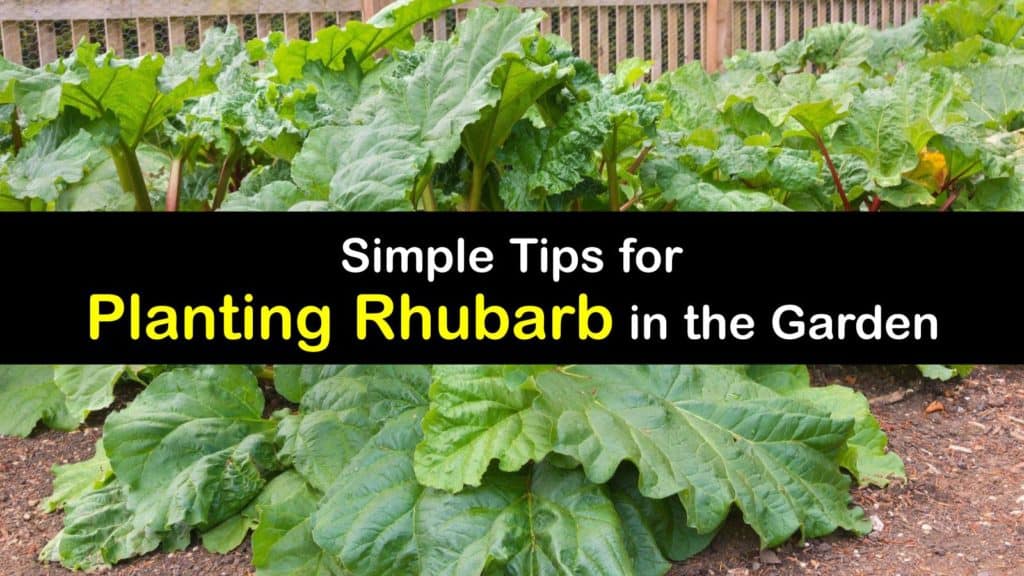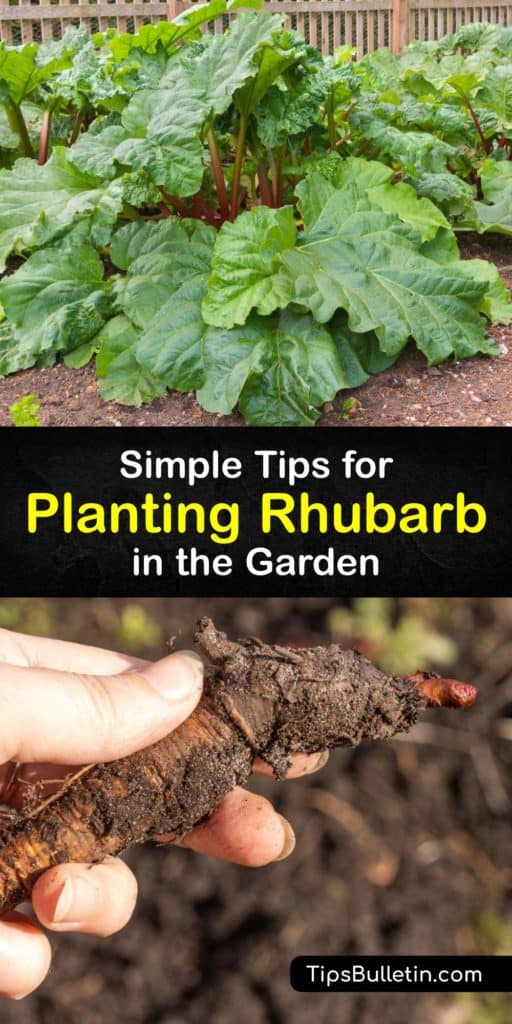If you’ve ever come across wild rhubarb, you likely have fond memories of picking the stems and taking them home to make a tart rhubarb pie. The rhubarb leaves are toxic, but the stems are undeniably delicious and something fun to plant in your personal garden. Learning how to plant rhubarb is something that gardeners of all experience levels can do.
However, you become flooded with questions if you’ve never done it before. Knowing how far apart to plant rhubarb and what it takes to keep it alive isn’t the same as some of the more traditional veggies people grow.
Planting rhubarb allows you to work with this unique plant and experiment with it in the kitchen. Rhubarb is used in both savory and sweet dishes. Rhubarb does have a tart taste, but those who love it truly can’t get enough of it.

About the Rhubarb Plant
Rhubarb is technically called Rheum rhabarbarum. They are perennial greens and vegetables native to Asia brought to Europe and America during the 1600s.
Rhubarb stalks thrive in cooler climates, making it an intelligent choice for gardeners in northern regions. Although it is easy to grow, it requires a dormancy period to show off its massive flower stalks in the future.
The rhubarb leaf stalks are the only edible part of the plant. The rhubarb roots and leaves are toxic to humans and should never be consumed. These toxic plant parts, especially the leaves, contain oxalic acid that irritates the body.
Planting rhubarb seeds means that you’ll get at least five years of life out of them; however, some last for decades. Once established, these plants don’t demand much work.

Their reddish stalks are rich in vitamins and minerals. They contain vitamin C and K, potassium, calcium, and folate, which help to lower cholesterol levels and provide beneficial antioxidants.
Things to Know about Planting Rhubarb
You decide that rhubarb plants are something that you want to grow. Now, where do you begin? This article contains everything about planting, caring for, and harvesting rhubarb in a raised bed or outdoor garden plot.
Some of the most popular cultivars are Canada Red, Macdonald, Valentine, and Victoria. Most rhubarb varieties are hardy in USDA zones one through seven.
When to Plant Rhubarb
The best way to plant rhubarb is to purchase rhubarb crowns harvested during their first year. Crowns are a part of the root system and are available at a local garden center or nursery.
When to plant rhubarb is in early spring. Plant the crowns just before the last frost or as soon as the ground is workable. If you plant in the fall, wait until dormancy sets in. It is possible to grow them from seed, but this process takes several years to produce a decent crop for harvesting.
Preparing to Plant Rhubarb
The place that you choose to plant your rhubarb is critical. There is little difference between Swiss chard and rhubarb in this regard. Once planted, you won’t want to mess with the rhubarb for a few years. Rhubarb does best in full sun but tolerate partial shade.
The site must have well-draining soil. Amend soil with organic matter, compost, or rotted manure. Rhubarb plants are heavy feeders, and adding these materials ensures they have adequate nutrition and keeps soil from becoming too tightly packed.
Ideally, keep the soil pH level between 6.0 and 7.0. Rhubarb makes large plants that spread at least two to three feet tall and wide. Give them plenty of room to develop in a location where they won’t be overcrowded.
How Far Apart to Plant Rhubarb
Rhubarb is large and needs a lot of space to spread its roots and leaves. Proper rhubarb plant spacing means there are at least four feet between each plant. The best way to grow rhubarb includes rows that are at least four feet apart.
How to Plant Rhubarb
Knowing how far apart to plant rhubarb is only one aspect. Your planting hole should be large and about the size of a bushel basket. Place the roots one to three inches below the soil surface.
After you cover them back up, water well and mulch generously around all of your plants. Straw or bark discourages weeds from fighting for nutrients and keeps the soil moist throughout the growing season.
Continue to water your plants through the first and second years. Remove the seed stalks or cut them back until they are an inch long because you want to keep them dormant until at least their third year.
Apply a light fertilizer every spring when the ground is thawing. Split rhubarb every three or four years if they become overgrown.
Harvesting Rhubarb
Planting rhubarb is the hardest part of the entire process. You won’t be able to stop devouring the red stalks once the harvest season takes place.
Do not harvest rhubarb until the third growing season to help it become well-established in its new home. You have about eight to ten weeks to harvest your crops in the mid-summer.
Harvest rhubarb stalks when they are 12 to 18 inches long and a three-quarter inch thick. If too thin, the food reserves are low, and it isn’t smart to cut them.
Grab the base of each stalk and use a sharp knife to cut them at the stalk base. Cut off all of the leaves and discard them.
If you have a great crop and can’t use it all at once, look for the best way to freeze rhubarb so you can enjoy it over the winter.
Common Rhubarb Pests and Diseases
Having a garden means that you also have to deal with pests and diseases. However, most rhubarb growing problems are not too serious and can be dealt with quickly.
The most common issues are rhubarb curculio, crown rot, leaf spot, and root rot. Most of these issues are avoidable by allowing your soil to drain correctly and not be overly soggy.
Cooking with Rhubarb
Those who haven’t tasted rhubarb don’t understand the magical flavor it has when cooked with sugar. Although tart, it makes a wonderful dessert and is fun to mix with strawberries, apples, or other fruits.
Combine the cornstarch and white sugar in a bowl. Stir in the rhubarb and strawberries until coated, and then spoon them into an ovenproof skillet.
In a separate glass bowl, mix the brown sugar, oats, butter, flour, and cinnamon until it looks like coarse crumbs. Sprinkle the rhubarb crumble over the fruit and bake everything at 350°F until crisp and bubbly, about 45 minutes.
Rhubarb is a plant that a lot of people look over. They don’t realize all the delicious possibilities that come from the crispy red stalks.
Hopefully, these how-to-grow-rhubarb tips have informed you about the process and persuaded you to try it yourself. Although it’s not as common as lettuce or tomatoes, this perennial plant may surprise you with how easy it is to maintain once established.

If learning how to plant rhubarb has diversified your vegetable garden, share this guide for planting rhubarb on Facebook and Pinterest.